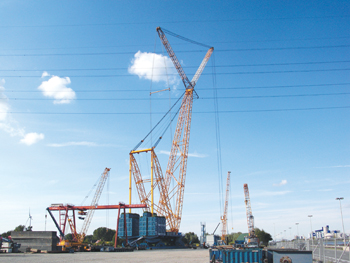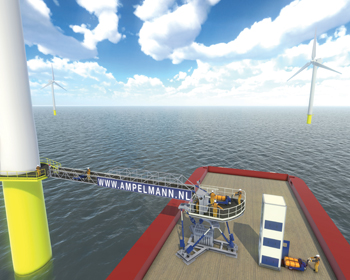
 Ampelmann A 400
Ampelmann A 400
At the core of the business is the unique technology of the Ampelmann system, a motion compensation gangway that allows safe, efficient and reliable access
Founded in 2007 as a spin-off of the Delft University of Technology, Ampelmann was established with the vision to make offshore access as easy as crossing the street. As such, our mission is to set new standards in safety by operating motion compensations offshore access solutions and services all over the world.
"From 2008 onwards we began to contract the system onto different projects within the offshore gas and offshore wind industries and have grown from one system to approximately 50 systems by the end of 2015. Growth has been positive since we last appeared in the magazine in January 2015, for example, we celebrated our one millionth safe transfer at the beginning of the year and are now almost at 1.9 million; we anticipate reaching two million transfers by the end of this year," says Frederik Gerner, Director of Ampelmann Asia Pacific.
At the core of the business is the unique technology of the Ampelmann system, a motion compensation gangway that allows safe, efficient and reliable access from moving vessels to offshore oil and gas platforms, offshore wind turbines, FPSO’s and other fixed and floating sea structures. Principally used to support offshore repair, construction and maintenance projects, the Ampelmann systems are safe, reliable and efficient in all types of weather. The fact that the Ampelmann systems can be used in all weathers is hugely important for operators as it means their offshore facilities can be accessed at all times, whatever the external conditions. This has clear economic benefits too, as renting an Ampelmann is more cost effective than hiring helicopters, larger vessels or inflexible jack-ups. Because an Ampelmann system can work 24 hours a day, the ship can simply be parked next to the structure and left so that a lot more man hours of actual work are achieved.
Ampelmann has a product portfolio of different offshore access solutions. The Ampelmann A-type is capable of compensating up to 2.5 metres significant wave height. This system is used to transfer people from a vessel or barge to a fixed or floating structure at sea as well as transferring small amounts of cargo or equipment.
The Ampelmann E-type is based on the same self-stabilising technology as the A-type, but has cylinders sized up to 1.5 times more than the A-type system. Essentially viewed as the big sister of the A-type, the E-type system is capable of operations in higher sea states as it can achieve compensation up to four metres significant wave height. The E-type can also be used for cargo transfer with weights of up to 100 tonnes.
The smallest Ampelmann system is the L-type, which is suited for small crews without DP as it is designed for crew boats or other smaller support vessels.
All these three systems are plug and play, operate stand alone with their own power packs and can be installed on any vessel with sufficient deck space. Operationally, no modifications to the platform are required.
The Ampelmann O-type is suitable for larger PSV vessels in moderate sea conditions and longer-term projects that require continuous access. Instead of using a hexapod, the system uses motion compensation technology to land the gangway to the platform; following this, the system goes to freefloat and low-power usage mode; this makes it possible for the O-type to stay connected to the platform for hours or days at a time.
Meanwhile, when it comes to the design of Ampelmann’s systems it is all about safety and therefore FMECA studies are executed to ensure all single failures of a critical component are covered by back-up components, while proper operational protocol is followed and checked against common sense. Not only are the systems fully certified under the Code forLifting Appliances in a Marine Environment, the systems are also checked by automotive experts in software fool-proofing; the company is also in continuous discussions with national HSE departments and its customer’s HSE experts to ensure there is a continuous improvement with regards to safe operations within its expanding fleet and the services offered. "Safety is key for us and our mission is to set new standards in safety by operating motion compensation offshore access systems and services all over the world," he says.



































































